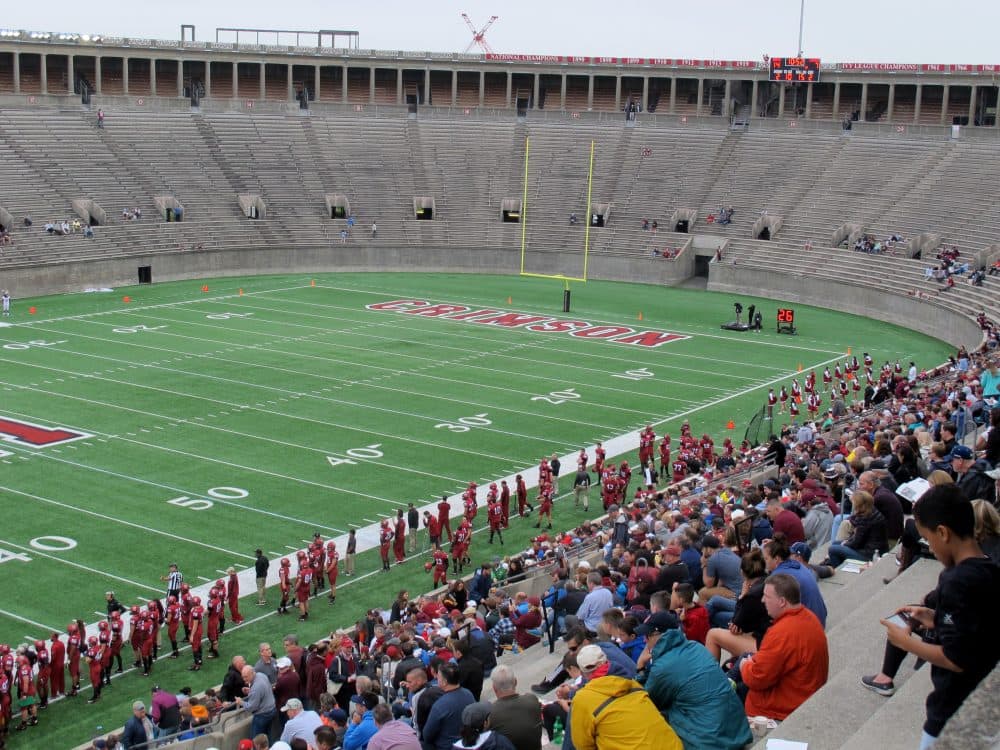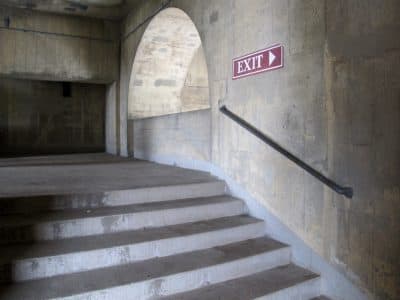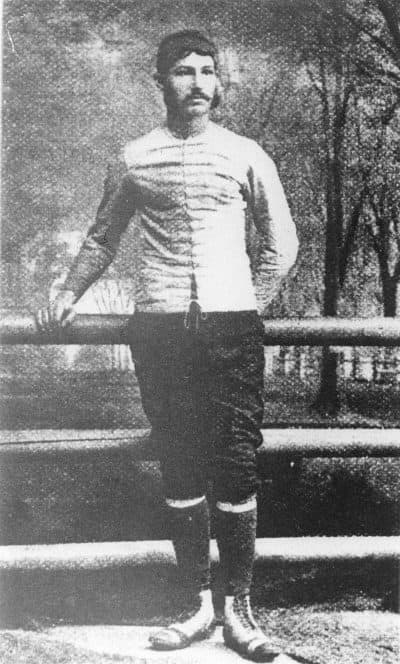Advertisement
History Of The Forward Pass
Football Deaths, The Forward Pass And 250K Cubic Feet Of Concrete

This is Part 2 in our episode on the origin of the forward pass.
For more, see: Part 1 | Part 3 | Part 4
Harvard Stadium has a Jumbotron, cheerleaders and a whole section for the cooler-than-cool pep band.
But, other than that, it doesn’t look like any other sporting venue in the world.
Well, there is this one place...
"The idea was to model it after the Roman Coliseum," says Dick Friedman, former Sports Illustrated editor and a Harvard alum. "That was what the architect submitted, and that was approved."
Harvard Stadium was the first permanent structure built for the game of football and, at the time, the largest steel-reinforced concrete building in the world.
"For people back then, they'd never seen anything like it. I mean, it was like being on the moon," Friedman says.
It’s shaped like a horseshoe, with Roman arches lining the outside walls and Greek columns on the inside.
When the stadium opened on Nov. 14, 1903, Harvard had already won three national championships. They’d win four more by 1919. And the place would be packed. At times, more than 50,000 people walked into Harvard Stadium on a Saturday afternoon.
Advertisement

More than a century later, fans still climb narrow stairs to sit on the stadium’s long, curved concrete benches. There are very few trappings of modernity.
"What you see is what you saw back in 1903, with a few little touches here and there. But this is — this is the original," Friedman says.
Football At The Turn Of The Century
But while Harvard Stadium hasn’t changed much since 1903, the game of football has. Dick Friedman’s spent a lot of time studying it.
"You look at the photos of the line of scrimmage, and you see 20 guys squashed in...and then a couple of guys standing in back," he says.
On nearly every play, these two masses of men would smash into each other in a cloud of dust.
"Once in a while, someone would break through with a long run. But, essentially, they would be gaining a few yards at a time," Friedman says.
Most of the excitement, and the points, came from the kicking game. Touchdowns were rare.
"Because the defense could bunch up right in front of the goal line and didn't have to worry about a pass going over their heads and didn't have to spread out," Friedman says.
So when two very good teams played against each other, "you had a lot of scoreless ties," Friedman says. "And a lot of the more astute commentators back then said that unless there was a way to get scoring higher, that the game would die of boredom and, not of violence."
Which was saying something — because on Oct. 15, 1905, The Washington Post reported that at least 45 football players had died since the turn of the century. The newspaper said:
"Picked up unconscious from beneath a mass of other players, it was generally found that the victim had been kicked in the head or stomach, so as to cause internal injuries or concussion of the brain, which, sooner or later, ended life."
Then there were the lesser injuries.
"Broken collarbones were very common. Broken fingers were common. It was a brutal game," says sports historian Ronald A. Smith.
One 'Huge, Immovable Problem'
Muckrakers focused on the brutality. They wanted football banned. In response, Friedman says, coaches and university administrators began looking for ways to make the game safer.
"And one of the ways that they came up with, and it actually made a lot of sense, was to widen the field."
The theory was, with a wider field, players couldn’t just stand shoulder to shoulder on the line of scrimmage. The defense would have to spread out to cover a ball carrier who ran straight for the sideline before heading down the field.
There was just one problem with this plan: "one, huge immovable problem," Friedman says. "Quite literally, it was set in stone. You could not widen the field within Harvard Stadium."
But there was another way to force the defense to spread out: the forward pass.
Smith says it wasn’t an entirely new idea. It was recommended by football player and coach John Heisman.
"But the person who most hated the forward pass was Walter Camp of Yale," Smith says.

Walter Camp is often called the "Father of American Football." He had almost complete control over the rules committee, and he had no interest in even considering the forward pass.
"It was making the game less tough by throwing the ball over the line instead of rushing through the line," Smith explains.
White House Visit
But Walter Camp had his chance to reform football. That came when he was summoned to the White House in October 1905 by President — and Harvard football fan — Teddy Roosevelt.
"He called the three leading institutions in American in sport, as well as education, Harvard, Yale and Princeton, down to the White House to discuss the unethical play that was going on and the brutality that was going on," Smith says.
Roosevelt told the men that it was their responsibility to lead the way in making the game safer. Because, where they went, the "lesser" schools would follow.
"In other words, this, kind of, trickle-down, Reagan philosophy," Smith says.
I know this will come as a shock, but the trickle down theory didn’t work. On the train back to their respective schools, the representatives of Harvard, Yale and Princeton considered some rules changes, but decided instead to issue a joint statement, pledging to tame the ills of the game and urging other schools to follow. But nothing much changed.
And then, on Nov. 21, 1905, in a game against New York University, a player for Union College was struck in the head, probably by the knee of one of his teammates. By the time the official blew his whistle, players had piled up on the ball. The Union College player was at the bottom — facedown and unconscious. He died hours later.
Henry MacCracken, the chancellor of NYU, decided he’d had enough. He called a meeting of all the schools NYU had played against over the past 10 years.
MacCracken hoped the attendees of this meeting would vote to ban football. Instead, they decided to reform it.
Reforming The Game
Meanwhile, schools across the country were dropping the sport, saying that it was just too violent. Even at Harvard, one of the school’s two governing boards called for the game to be banned — much to the dismay of Harvard’s young coach, Bill Reid.
"Reid heard that they might be doing this, and so he asked the Harvard Athletic Association to set up a committee to reform intercollegiate athletics," Smith says. "This group comes up with 19 suggestions."
One of those suggestions was the forward pass.
Instead of bringing his list to the old rules committee — the one dominated by the forward pass-hating Walter Camp — Reid brought it to MacCracken’s group.
"And Reid tells this new rules committee, he says, 'If we don't get these 19 rules passed, Harvard is going to vote football out,' " Smith says.
MacCracken’s committee agreed to Harvard’s demand to institute the forward pass, and Harvard agreed to join them in reforming the game.
"And when Harvard moved over, Yale and Princeton almost had to do, and so they jointly came up with rules," Smith says.
"You know, I think a little bit more is made of this split/schism," Friedman says. "It's not the Catholic Church in the 1400s, you know, I mean that kind of thing. Eventually, everybody had to be on board with the forward pass, and they were."
'Maybe We Should Be Throwing The Ball Forward'
Eventually, the threat of the forward pass worked to help spread out the defense and open up the game. But under the 1906 rules, only a fool would actually try to use it.
"Pass interference was legal," Friedman says. "You know, guy could be running out to try to catch the pass and you could do anything to him. You could mug him."
If the receiver dropped the ball, the offense would be penalized 15 yards. If the ball fell to the ground without anyone touching it, the team would lose possession.
"It took a few years for these rules to work themselves out, but none of this would have happened if Harvard Stadium could have been wider," Friedman says.
Are you sure?
"Or it probably wouldn't have happened — maybe, probably ... eh, I don't know. Eventually somebody would have said, 'Eh, maybe we should be throwing the ball forward, you know, could be fun.' "
This segment aired on December 16, 2017.
